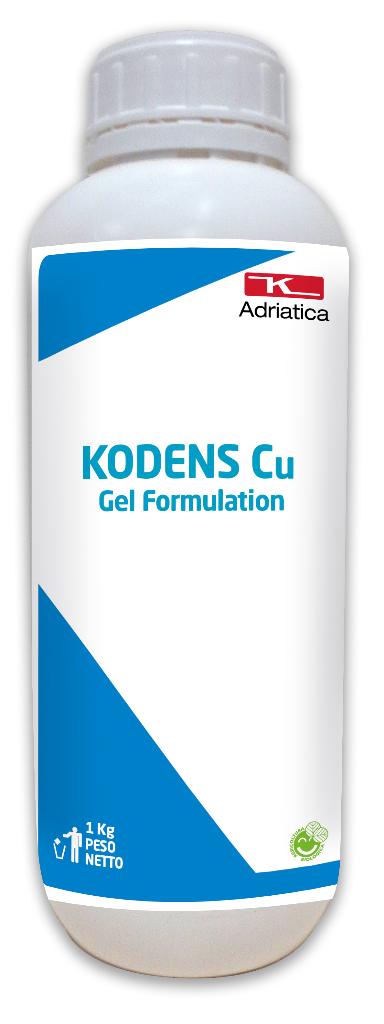

Packaging 1 - 6 kg
NATURAL RESISTANCE INDUCERS
KODENS Cu GEL FORMULATION
IMPROVES CROP PHYSIOLOGICAL CONDITIONS
INCREASES RESISTANCE TO DISEASES AND ENVIRONMENTAL ADVERSITIES
HIGH EFFICACY WITH REDUCED COPPER DOSE RATES
ALLOWED IN ORGANIC FARMING
KODENS CU Gel formulation is a nutritional specialty that target the crops' general conditions and their balanced growth.
It contains copper complexed by gluconic acid. This is a natural complexing agent that speeds nutrients' uptake and translocation through the sap with the effect to stimulate photosynthesis, acting as a powerful plant anti-stress. This allows you to maximize results already at low dosages.
The anti-stress action is enhanced by the presence of boron, which causes a greater lignification of the tissues and a strengthening of the stem, thus increasing plant mechanical resistance to damages caused by biotic and abiotic agents.
Its gel formulation makes KODENS CU Gel formulation a product with high wettability, adhesiveness and assimilation through the cuticle. Thanks to its activity, selectivity and resistance to leaching, it ensures a better and prompt nutrient assimilation by the plant. The uniqueness of the formulation allows to obtain a rapid availability of the active principle associated with a continuous and gradual release of copper ions. Therefore, by combining promptness and persistence of action, the highest efficacy of the treatment is guaranteed even in the toughest agronomic and pedoclimatic conditions.
The systematic use of the product induces a marked elicitor action (endogenous production of secondary metabolites), which triggers the crop's natural resistance to the development of fungi, bacteria and viruses.
| Culture | Time of application | Dose/hectare* |
|---|---|---|
| Grapes e Kiwifruit | Throughout the whole crop cycle |
2-3 kg
|
| Olive e Citrus (Tangerine, Lemon, Clementine, Bergamot, Orange) | Throughout the whole crop cycle |
2-3 kg
|
| Stone fruits (Plum, Peach, Nectarine, Cherry, Apricot) e Pome fruits (Pear, Apple, Quince) | Throughout the whole crop cycle |
2-3 kg
|
| Small fruits (Currant, Blackberry, Blueberry, Raspberry) e Strawberries | Throughout the whole crop cycle |
2-3 kg
|
| Fruiting vegetables (Pumpkin, Zucchini, Tomato, Pepper, Melon, Eggplant, Cucumber, Watermelon) | Throughout the whole crop cycle |
2-3 kg
|
| Leafy vegetables (Spinach, Celery, Escarole, Rocket, Radicchio, Lettuce, Chicory) | Throughout the whole crop cycle |
2-3 kg
|
| Industrial crops (Tobacco, Soybeans, Industrial tomato, Sunflower, Cotton, Rapeseed, Sugarcane, Beets) | Throughout the whole crop cycle |
2-3 kg
|
| Flowers and ornamentals | Throughout the whole crop cycle |
2-3 kg
|
| Protected crops (vegetables, flowers) | Throughout the whole crop cycle |
2-3 kg
|
| Nurseries e Seedbeds | Throughout the whole crop cycle |
2 kg
|
-
Grapes e Kiwifruit2-3 kgThroughout the whole crop cycle
-
Olive e Citrus (Tangerine, Lemon, Clementine, Bergamot, Orange)2-3 kgThroughout the whole crop cycle
-
Stone fruits (Plum, Peach, Nectarine, Cherry, Apricot) e Pome fruits (Pear, Apple, Quince)2-3 kgThroughout the whole crop cycle
-
Small fruits (Currant, Blackberry, Blueberry, Raspberry) e Strawberries2-3 kgThroughout the whole crop cycle
-
Fruiting vegetables (Pumpkin, Zucchini, Tomato, Pepper, Melon, Eggplant, Cucumber, Watermelon)2-3 kgThroughout the whole crop cycle
-
Leafy vegetables (Spinach, Celery, Escarole, Rocket, Radicchio, Lettuce, Chicory)2-3 kgThroughout the whole crop cycle
-
Industrial crops (Tobacco, Soybeans, Industrial tomato, Sunflower, Cotton, Rapeseed, Sugarcane, Beets)2-3 kgThroughout the whole crop cycle
-
Flowers and ornamentals2-3 kgThroughout the whole crop cycle
-
Protected crops (vegetables, flowers)2-3 kgThroughout the whole crop cycle
-
Nurseries e Seedbeds2 kgThroughout the whole crop cycle
-
 Foliar fertilization
Foliar fertilization






